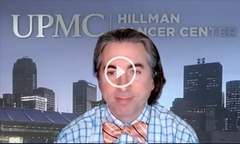
REALITIVTY-047 Study Design Shows Mature Response Results in Melanoma
Jason Luke, MD, discusses how the gated design of the REALITIVITY-047 led to results being delivered in phases for patients with advanced melanoma treated with the combination of relatlimab and nivolumab.
Episodes in this series

Jason Luke, MD, associate professor of medicine in the Division of Hematology/Oncology and the director of the Cancer Immunotherapeutics Center at the UPMC Hillman Cancer Center, discusses the unique design of the RELATIVITY-047 trial (NCT03470922) that demonstrated the efficacy of nivolumab (Opdivo) plus relatlimab (Opdualag) in patients with advanced melanoma.
The phase 2/3 global, double-blind, randomized trial evaluated the fixed dose combination of the PD-1 and LAG-3 immunotherapy combination against nivolumab alone for patients with previously untreated metastatic or unresectable melanoma.
Ultimately, the study met its primary end point of progression-free survival (PFS) with a median PFS of 10.1 months (95% CI, 6.4-15.7) for patients on the combination therapy compared with 4.6 months (95% CI, 3.4-5.6) with nivolumab alone (HR, 0.75; 95% CI, 0.62-0.92, P = .006). At 12-months the PFS rate still favored the combination therapy vs the monotherapy at 47.7% vs 36.0%, respectively, and key subgroups experienced similar PFS benefits with the addition of relatlimab.
However, Luke points out the road to getting these data took extra time as the data were gated in order to assess if the phase 2 portion of the study was showing enough benefit in patients in order to move to the phase 3 portion and widen the scope of the trial. This led to the main results of PFS being reported first. Luke says that with more mature data, an efficacy benefit was seen in the objective response rate (ORR) of patients receiving the combination therapy, whereas overall survival (OS) did not quite reach the statistical threshold set out by researchers but showed relevancy.
In the updated data, median OS was not reached but at 12 months and 24 months the OS rates favored the combination therapy over the monotherapy at 77.0% vs 71.6% and 63.7% vs 58.3%, respectively. For patients given relatlimab plus nivolumab their confirmed ORR was 43.1% (95% CI, 37.9-48.4) compared with 32.6% (95% CI, 27.8-37.7) with 16.3% of responses in the combination arm being complete responses.
Transcription:
0:08 | [This was a] very interesting study design where the study began as a phase 2 study looking for an interval outcome that would trigger the full accrual of the phase 3 [study]. So obviously that happened, and the trial eventually read out showing that the primary end point was met with an improvement in PFS. Due to the sort of unusual study design with this gated approach, however, the data came in sort of in phases, meaning that the patients treated in the phase 2 [portion] read out earlier than the patients in the phase 3 [portion].
0:47 | That led to an idiosyncrasy that when we got the first results REALITIVTY-047, we only knew that the primary end point of PFS had been met, but we did not know about the data for ORR or for OS. With more mature follow-up, we now see that there's also a benefit for ORR and OS appears to be clinically relevant, albeit it didn't quite meet the statistical threshold that was predefined in the clinical trial. So, on a high level then, what we see is that adding relatlimab to nivolumab does improve, by statistical design, PFS and ORR, but OS just slightly did not meet its goal.














































